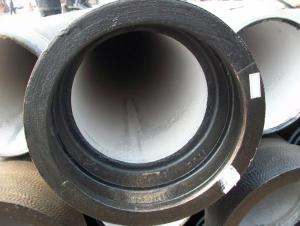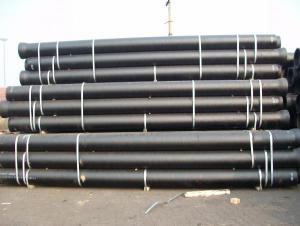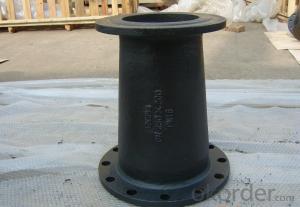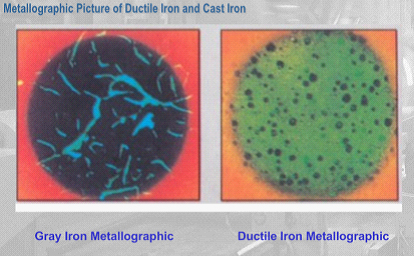Self-restrained Joint Ductile Iron Pipe
- Loading Port:
- China Main Port
- Payment Terms:
- TT or LC
- Min Order Qty:
- 1 Metric Ton m.t.
- Supply Capability:
- 300000 Metric Tons per Year m.t./month
OKorder Service Pledge
OKorder Financial Service
You Might Also Like
Overview of Ductile Iron Pipe
Ductile cast iron, also called ductile iron, spheroidal graphite iron, or nodular cast iron, is a type of cast iron invented in 1943. While most varieties of cast iron are brittle, ductile cast iron is much more flexible and elastic, due to its nodular graphite inclusions.
Graphite particles exist in the form of sphericity in ductile cast iron. Sizes graphite particle are restricted to 6 -7 class and spheroidizing rate should not be less than 80%. Thus after the spheroidizing process, ductile iron will be endowed with mechanical properties of both cast iron and steel.
Much of the production of ductile iron is in the form of ductile cast iron pipe, used for water supply and sewerage design. Ductile cast iron pipe is stronger and easier to tap, requires less support and provides greater flow area compared with pipes made from other materials like PVC, concrete, polyethylene or steel. Ductile Iron Pipe is the most widely-used pipeline product in water supply and water drain/sewage projects.
General introduction of Self-restrained Joint Ductile Iron Pipe
•Material : Ductile Cast Iron
•Size Range : DN 80mm to DN 1200mm
•Unit Effective Length : 6m or 5.7m or negotiable
•Manufacture Standard: ISO 2531:1998/ EN 545:2006/EN 598:2007
•Annual capacity : 300,000 tons
•Coating Exterior: Zinc 130g/m2 according to ISO 8179-1 and bitumen coating 70 microns.
•Cement Interior: Portland Cement/ High Alumina Cement/ Sulphate Resisting Cement Lining according to ISO 4179
•Special requirements on external coating and internal lining can be applied
•We also provide accessories such as SBR/EPDM rubber gaskets, lubricant paste, pipe caps, PE sleeves, etc.
Mechanical Properties
|
Item |
Tensile Strength (N/mm2) |
Elongation(%) |
Proof Stress (N/mm2) |
Hardness HB | ||
|
DN80 TO DN2600 |
DN80 TO DN1000 |
DN1100 TO DN2000 |
DN80 TO DN1000 |
DN100 TO DN2000 | ||
|
Pipe |
≥420 |
≥10 |
≥7 |
≥270 |
≥300 |
≤230 |
|
Fittings |
≥420 |
≥5 |
≥300 |
≤250 | ||
Standard Lining and Coating
External Protection
Metallic zinc complying with the standard ISO8179,and bitumen,or special protective coating according to the customer’s requirement.
Notes:
. Pipes and fittings conform to the requirements of International Standard ISO 2531,British Eurpean Standard BS
. EN545,and their extensions. If information given in English and Chinese differs,the English version prevails.
. Dimensions and masses of pipes and fittings are approximate and are for refererces only;accurate dimensions and
. masses should be confirmed with us at the time of placing order. Flanged joint pipes and fittings are generally
. available with PN10,PN16 and PN25. Socketed joint pipes and fittings generally available with T type and K type joints.
Features of Self-restrained Joint Ductile Iron Pipe:
. Ductile Iron Pipe offers proven reliability and the quality.
. It is quick and easy installation.
. The ductile iron pipe has high pressure capability.
Application:
Used for water and sewer lines.
Production Process
Much of the production of ductile iron is in the form of ductile cast iron pipe, used for water supply and sewerage design. Ductile iron pipe is stronger and easier to tap, requires less support and provides greater flow area compared with pipes made from other materials like PVC, concrete, polyethylene or steel.
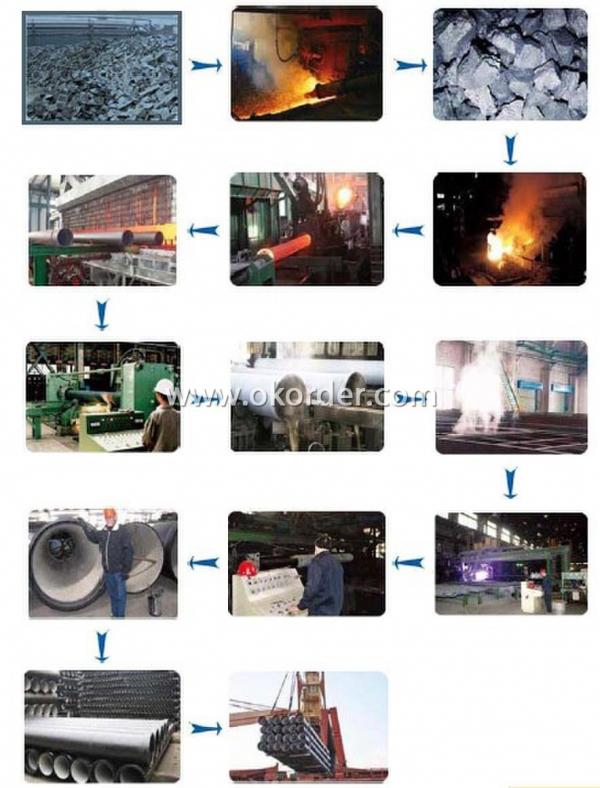
Specification of Self-restrained Joint Ductile Iron Pipe:
Standard wall thickness of Self-restrained Joint Ductile Iron Pipe
|
Nominal Diameter |
Wall Thickness(mm) | ||||||
|
DN(mm) |
Pipe |
Fittings | |||||
|
Class C |
K8 |
K9 |
K10 |
K12 |
K12 |
K14 | |
|
80 |
4.4 |
6 |
6.0 |
7 |
8.1 | ||
|
100 |
4.4 |
6.0 |
7.2 |
8.4 | |||
|
125 |
4.5 |
6.3 |
7.5 |
8.8 | |||
|
150 |
4.5 |
6.3 |
7.8 |
9.1 | |||
|
200 |
4.7 |
6.3 |
8.4 |
9.8 | |||
|
250 |
5.5 |
6.8 |
7.5 |
9 |
9 |
10.5 | |
|
300 |
6.2 |
6.4 |
7.2 |
8 |
9.6 |
9.6 |
11.2 |
|
350 |
6.3 |
6.8 |
7.7 |
8.5 |
10.2 |
10.2 |
11.9 |
|
400 |
6.5 |
7.2 |
8.1 |
9 |
10.8 |
10.8 |
12.6 |
|
450 |
6.9 |
7.6 |
8.6 |
9.5 |
11.4 |
11.4 |
13.3 |
|
500 |
7.5 |
8 |
9 |
10 |
12 |
12 |
14 |
|
600 |
8.7 |
8.8 |
9.9 |
11 |
13.2 |
13.2 |
15.4 |
|
700 |
8.6 |
9.6 |
10.8 |
12 |
14.4 |
14.4 |
16.8 |
|
800 |
9.6 |
10.4 |
11.7 |
13 |
15.6 |
15.6 |
18.2 |
|
900 |
11.6 |
11.2 |
12.6 |
14 |
16.8 |
16.8 |
19.6 |
|
1000 |
12.6 |
12 |
13.5 |
15 |
18 |
18 |
21 |
|
1200 |
13.6 |
13.6 |
15.3 |
17 |
20.4 |
20.4 |
22.8 |
|
1400 |
15.7 |
15.2 |
17.1 |
19 |
22.8 |
22.8 |
26.6 |
|
1500 |
16.7 |
16 |
18 |
20 |
24 |
24 |
31 |
|
1600 |
17.7 |
16.8 |
18.9 |
21 |
25.2 |
25.2 |
29.4 |
|
1800 |
19.7 |
18.4 |
20.7 |
23 |
27.6 |
27.6 |
32.2 |
|
2000 |
21.8 |
20 |
22.5 |
25 |
30 |
30 |
35 |
Self-restrained Joint
Self-restrained Type is a push-in self anchored joint. The principle of joint anchoring consists in transmitting the axial forces from one pipeline to the following one, thus ensuring that the joint does not come apart.
The application of self-restrained joints is of particular interest where congested conditions preclude concrete anchor block constructions or in poorly cohesive soils.Self-restrained joints combine the advantages of flexible joint pipes and welded joint pipes.
Photo of Self-restrained Joint Ductile Iron Pipe
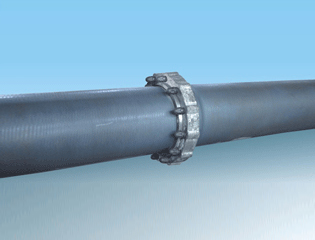
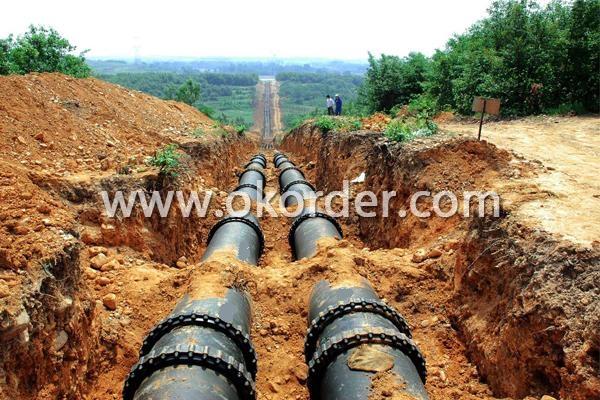
- Q:How are ductile iron pipes transported and stored?
- To ensure the safety and integrity of ductile iron pipes, a systematic and cautious approach is taken during their transportation and storage. Typically, specialized vehicles such as flatbed trucks or trailers are used to transport ductile iron pipes. These vehicles are specifically designed to accommodate the size and weight of the pipes. They are equipped with securing mechanisms that effectively prevent any movement or damage during transit. Forklifts or cranes are used to load the pipes onto the vehicles, ensuring proper support and balance to prevent bending or deformation. To protect the pipes from external factors that may cause damage, measures are taken during transportation. Covers or wraps are placed over the pipes to shield them from adverse weather conditions such as rain, snow, or excessive sunlight. Straps or chains are also used to secure the pipes, preventing any shifting or rolling during transit. During storage, ductile iron pipes are stacked horizontally on specially designed racks or supports. This ensures even weight distribution and minimizes the risk of deformation or stress on the pipes. The storage area must be clean, dry, and well-ventilated to prevent corrosion or deterioration. It is crucial to handle ductile iron pipes with care to avoid impact or rough handling that could result in cracks or fractures. Workers involved in the transportation and storage process must receive proper training to ensure they adhere to protocols and use the necessary equipment, including lifting machinery and protective gear. Regular inspections of transported and stored ductile iron pipes are necessary to identify any signs of damage or corrosion. This allows for timely repairs or replacements, preventing any issues when the pipes are installed for their intended use. In conclusion, the transportation and storage of ductile iron pipes necessitate meticulous planning, appropriate equipment, and adherence to safety protocols to maintain their condition and performance.
- Q:What is the relationship between the mechanical properties of spheroidal graphite cast iron and its spheroidization rate?
- The spheroidization level reflects only the final shape of graphite. The higher the spheroidization level of ductile iron is, the better its performance is, but this is not entirely the level of spheroidization to determine.The mechanical properties of nodular cast iron are closely related to its microstructure. Different grades of ductile iron require different mechanical properties such as tensile, yield, elongation, impact and hardness.
- Q:Can ductile iron pipes be used for underground irrigation systems?
- Indeed, underground irrigation systems can utilize ductile iron pipes. These pipes find extensive use in a multitude of applications, such as water supply and distribution systems. Renowned for their robustness, durability, and resistance to corrosion, ductile iron pipes prove ideal for subterranean installations. Moreover, they possess exceptional pressure-bearing capabilities, enabling them to endure the elevated pressures commonly associated with irrigation systems. Nevertheless, it remains crucial to guarantee appropriate installation and maintenance to avert any potential harm or leakage within the system.
- Q:Can ductile iron pipes be used for pressure relief systems?
- Indeed, pressure relief systems can make use of ductile iron pipes. Renowned for their robustness, longevity, and capacity to endure intense pressure circumstances, ductile iron pipes possess a remarkable resilience against both internal and external pressures. Consequently, they prove to be ideal for deployment within pressure relief systems. Furthermore, ductile iron pipes can withstand considerable fluctuations in pressure without jeopardizing their structural integrity. Consequently, they find widespread usage in various settings necessitating pressure relief systems, including water supply networks, wastewater treatment facilities, and industrial operations.
- Q:Are ductile iron pipes suitable for railway crossings?
- Railway crossings can indeed utilize ductile iron pipes. Ductile iron, a robust and long-lasting material, finds extensive use in numerous applications, which include water and sewage systems. Its exceptional tensile strength and flexibility allow it to withstand heavy loads and vibrations, both of which are commonly encountered in the vicinity of railway crossings. Moreover, ductile iron pipes exhibit exceptional resistance to corrosion, making them particularly valuable in areas prone to moisture and exposure to diverse weather conditions. This resistance guarantees the pipes' durability, ultimately reducing the need for maintenance and replacement, thus cutting costs. Furthermore, ductile iron pipes are renowned for their effortless installation and versatility. They seamlessly integrate with other pipe types and fittings, facilitating their incorporation into the overall railway crossing infrastructure. However, it is important to bear in mind that the suitability of ductile iron pipes for railway crossings hinges on various factors, such as load requirements, soil conditions, and specific project specifications. Consulting engineering professionals and adhering to industry standards and regulations is vital to ensure the appropriate selection and installation of ductile iron pipes for railway crossings.
- Q:Can ductile iron pipes be used for gas distribution systems?
- Yes, ductile iron pipes can be used for gas distribution systems. Ductile iron pipes are known for their strength and durability, making them suitable for carrying various types of fluids, including natural gas. These pipes have excellent corrosion resistance and can withstand the high pressure and stress typically associated with gas distribution systems. Additionally, ductile iron pipes are cost-effective and have a long lifespan, making them a reliable choice for gas distribution networks.
- Q:Can centrifugal cast iron pipe be galvanized or coated with asphalt which is good for corrosion prevention?
- By spraying zinc and epoxy coal tar coating of ductile iron pipe wall (or epoxy resin paint, polyurethane, etc.) wall using Portland cement (or epoxy powder, epoxy, polyurethane, ceramics etc.) wall coating can effectively active substances in soil and the formation of an insoluble zinc salt protection tube, the internal coating can inhibit corrosion of pipe body fluid medium.
- Q:Fire water supply network adopts ductile iron pipe, the test pressure should be no more than MPa
- To your selected fire pump highest lift 1.5 times to suppress, generally not more than 1.6MPa, if the use of ductile iron pipe, test pressure according to 2MPa to suppress.
- Q:How do ductile iron pipes handle water hammer?
- Ductile iron pipes possess excellent resistance to water hammer, which is the sudden increase in pressure and velocity of water flow in a pipe system. This occurrence happens when there is an abrupt change in water velocity, like the sudden closure of a valve or the immediate shutdown of a pump. The design of ductile iron pipes enables them to withstand high-pressure surges caused by water hammer. Their increased strength and flexibility allow them to absorb and dissipate the energy generated during these pressure surges. The material's ductility permits the pipe to undergo slight deformation when impacted by water hammer, preventing the pipe from rupturing or breaking. Moreover, ductile iron pipes possess inherent damping properties that make them more effective at absorbing and dissipating the energy of water hammer compared to other pipe materials. This aids in reducing the intensity and duration of pressure surges, thereby minimizing potential damage to the pipe system and its components. Furthermore, ductile iron pipes often come equipped with various fittings and accessories that further enhance their capability to handle water hammer. These include specialized joint designs like restrained joints or flexible couplings, which provide additional flexibility and resistance to pressure surges. In summary, ductile iron pipes are specifically engineered to address the challenges presented by water hammer. Their strength, flexibility, damping properties, and specialized fittings make them an ideal choice for applications where water hammer is a concern, offering a reliable and durable solution for water distribution systems.
- Q:Are ductile iron pipes suitable for use in irrigation canals?
- Ductile iron pipes excel in irrigation canals due to their robustness and endurance. Their exceptional strength and durability make them an optimal selection for water transportation in irrigation systems. With remarkable tensile strength, they withstand the demanding loads and pressures regularly encountered in irrigation canals. Moreover, their remarkable corrosion resistance makes them an ideal fit for environments with varying water quality. Additionally, they possess resistance against UV rays and extreme weather conditions, guaranteeing their long lifespan within irrigation canal systems. Additionally, ductile iron pipes efficiently handle high flow rates, enabling efficient water transportation over extensive distances, ensuring effective irrigation. In summary, ductile iron pipes offer an array of advantages and are a trustworthy and fitting option for usage in irrigation canals.
1. Manufacturer Overview |
|
|---|---|
| Location | Henan, China |
| Year Established | 1958 |
| Annual Output Value | Below US$1 Million |
| Main Markets | Mid East, Africa, South Asia, Eastern Asia |
| Company Certifications | ISO 9001:2008;ISO2531:2000 |
2. Manufacturer Certificates |
|
|---|---|
| a) Certification Name | |
| Range | |
| Reference | |
| Validity Period | |
3. Manufacturer Capability |
|
|---|---|
| a)Trade Capacity | |
| Nearest Port | Tianjin; Qingdao |
| Export Percentage | 1% - 10% |
| No.of Employees in Trade Department | 3000 People |
| Language Spoken: | English; Chinese; Spain; Alabic |
| b)Factory Information | |
| Factory Size: | Above 150,000 square meters |
| No. of Production Lines | Above 6 |
| Contract Manufacturing | OEM Service Offered; Design Service Offered |
| Product Price Range | Average |
Send your message to us
Self-restrained Joint Ductile Iron Pipe
- Loading Port:
- China Main Port
- Payment Terms:
- TT or LC
- Min Order Qty:
- 1 Metric Ton m.t.
- Supply Capability:
- 300000 Metric Tons per Year m.t./month
OKorder Service Pledge
OKorder Financial Service
Similar products
New products
Hot products
Hot Searches
Related keywords

